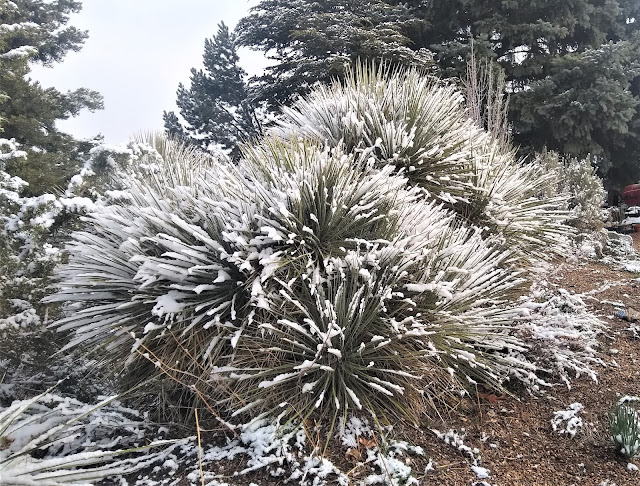 |
| Tulipa greigii 4-22-2021 |
I remember flying into Rochester in late March of 1978 and seeing huge mounds of snow everywhere and feeling so sorry for the locals. I remember my first visit to Flagstaff, a few years earlier. That was in May, and there were enormous mounds of snow in the parking lots there as well...We'd had more normal springs around then (if there is a thing as a "normal spring" anywhere...this year it's apparently Denver's turn for a mini-Ice Age. A friend emailed me to say we're the second snowiest city in the continental U.S. this year--right after Worcester, Massachusetts. Woo hoo! Poor Worcester!
The snows have been coming just about every week, sometimes twice or three times in a week--but it will thaw enough for flowers to emerge, and even this athletic Fritillary to rise nearly two feet. Miraculously, it seems to have weathered at least 3 snowstorms, despite temperatures dropping into the teens several nights. They must have a lot of antifreeze in them!
There is a beauty, I admit, and a purity of freshly fallen snow. It was rather charming back in December... the charm has long since worn off: every Denverite I meet is grumbling about it.
Stange how it melts from the pathways and sidewalks before it melts on the garden or lawn....
I suppose Erythronium tuolumnense must get some spring snow on it in California--although it's not the highest elevation glacier lily.
This Fritillaria crassifolia reveals its steppe ancestry by holding up so well in the snow...
This one, not so much. It really reflects the way Denverites are feeling...especially when I see the NOAA forecast for next Wednesday reads: "A chance of rain and snow showers. Some thunder is also possible." Fortunately, they appended this: "Mostly sunny, with a high near 60"....I like the last part best!










The snow melts from the path first because the ground is compacted. Compaction removes air pockets which act as insulation. Since the compacted ground transfers heat faster, the snow melts quicker. Another part of your garden where the snow melts quicker is on the rocks. Rocks transfer heat well. This makes them helpful for moderating temperature extremes in climates like you have in Denver. The rocks will make microclimates slightly warmer in the cold and cooler in the heat. Beside the fact that they look good, this moderating effect is a good reason to grow things in a rock garden. However, I am sure you know all of the above.
ReplyDeleteI have a few things that come up early and typically get knocked back by frost. One is Hosta plantaginea planted on the south side of my house. The other is Kirengeshoma palmata. This year I tried mulching the Hosta with about 8" of chopped leaves. The hosta leaves have only come up along the edges where the mulch was thin or there was a block wall border. I am really amazed at how much this mulch of leaves has delayed the emergence of the hosta leaves. This might be something you could try in your garden to delay the emergence of your tall Fritillaria imperialis(?) until the risk of extreme cold was less.
You articulated the power of air and stone well, James: I'm embarrassed to admit I'd never thought about it that much. Thank you! A fine explanation.
ReplyDelete